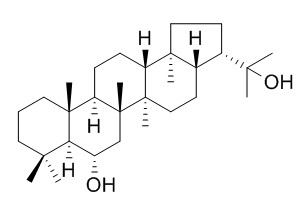Zeorin
Zeorin shows strong inhibition activity against bacteria and fungi. It markedly exhibits inhibitory activity on histamine release from mast cell induced by DNP24-BSA, it shows potent inhibitory effect by 40% decrease of histamine release.
Inquire / Order:
manager@chemfaces.com
Technical Inquiries:
service@chemfaces.com
Tel:
+86-27-84237783
Fax:
+86-27-84254680
Address:
1 Building, No. 83, CheCheng Rd., Wuhan Economic and Technological Development Zone, Wuhan, Hubei 430056, PRC
Providing storage is as stated on the product vial and the vial is kept tightly sealed, the product can be stored for up to
24 months(2-8C).
Wherever possible, you should prepare and use solutions on the same day. However, if you need to make up stock solutions in advance, we recommend that you store the solution as aliquots in tightly sealed vials at -20C. Generally, these will be useable for up to two weeks. Before use, and prior to opening the vial we recommend that you allow your product to equilibrate to room temperature for at least 1 hour.
Need more advice on solubility, usage and handling? Please email to: service@chemfaces.com
The packaging of the product may have turned upside down during transportation, resulting in the natural compounds adhering to the neck or cap of the vial. take the vial out of its packaging and gently shake to let the compounds fall to the bottom of the vial. for liquid products, centrifuge at 200-500 RPM to gather the liquid at the bottom of the vial. try to avoid loss or contamination during handling.
Food Quality and Safety2018, 2:213-219
Metabolites2022, 12(6),507.
Korean J. Medicinal Crop Sci2021, 10:345-352.
Biomed Chromatogr.2020, e5021.
Plants (Basel).2020, 9(11):1535.
J of the Society of Cosmetic Scientists of Korea2018, 44(4):407-417
Front Pharmacol.2017, 8:205
Food Control2022, 132:108434.
Phytomedicine.2017, 24:77-86
Plants (Basel).2021, 10(2):278.
Related and Featured Products
Fungal Biol. 2011 Apr-May;115(4-5):401-5.
Chemical taxonomy of Torrubiella s. lat.: zeorin as a marker of Conoideocrella.[Pubmed:
21530922]
The insect pathogens in the genus Torrubiella s. lat. were recently divided into new genera based on molecular phylogenetic characters.
METHODS AND RESULTS:
Isolates collected at various locations in Thailand, were tested for their productivity of a hopane-type triterpene, Zeorin (6α,22-dihydroxyhopane), when cultured in potato dextrose broth under static conditions. Among the 49 strains of Torrubiella s. lat. species, Conoideocrella luteorostrata (ten strains) and C. tenuis (seven strains), all collected on scale insects (Hemiptera), produced Zeorin, whereas another six strains of Orbiocrella petchii (which was recently removed from Torrubiella) failed in the detection of this secondary metabolite. All other Torrubiella s. lat. (26 strains), collected on other insect hosts including leafhoppers (eight strains), Lepidoptera (one strain), and spiders (17 strains), produced no detectable Zeorin. Paecilomyces cinnamomeus (nine strains), the anamorph of C. luteorostrata, also produced Zeorin.
CONCLUSIONS:
These results correspond with the recent taxonomic reclassification based on multigene phylogeny.
African journal of microbiology research.2010 Apr; 4:885-890.
Antimicrobial activity of the lichen Lecanora frustulosa and Parmeliopsis hyperopta and their divaricatic acid and zeorin constituents.[Reference:
WebLink]
METHODS AND RESULTS:
Antibacterial and antifungal activity of the acetone, methanol and aqueous extracts of the lichen Lecanora frustulosa and Parmeliopsis hyperopta and their divaricatic acid and Zeorin constituents has been screened in vitro against the following species of microorganisms: Bacillus mycoides, Bacillus subtilis, Staphylococcus aureus, Enterobacter cloaceae, Escerichia coli, Klebsiella pneumoniae, Aspergillus flavus, Aspergillus fumigatus, Botrytis cinerea, Candida albicans, Fusarium oxysporum, Mucor mucedo, Paecilomyces variotii, Penicillium purpurescens, Penicillium verrucosum and Trichoderma harsianum.Divaricatic acid and Zeorin also showed strong activity against bacteria and fungi.
Int. J. Pharm. Clin. Res.,2015; 7(6):420 -5.
Effects of zeorin and dustanin isolated from Aegle marmelos correa on histamine released from RBL-2H3 cells.[Reference:
WebLink]
Two compounds have been isolated from the leaves and stem barks of Aegle marmelos Correa. They were Zeorin (6,22-dihydroxyhopane) and dustanin (15,22-dihydroxyhopane). A. marmelos has an indication as anti-inflammatory and anti-allergy.
METHODS AND RESULTS:
In the study, these compounds were evaluated for their inhibitory effect on histamine release from mast cell culture, rat basophilic leukemia (RBL-2H3) cell line, a tumor analog of mast cells. Histamine release from mast cell was induced by DNP24-BSA and thapsigargin, an immunologic and non-immunologic inducers respectively. The histamine release was determined by using HPLC with fluorometric detector. In the study, only Zeorin markedly exhibited inhibitory activity on histamine release from mast cell induced by DNP24-BSA. Zeorin showed potent inhibitory effect by 40% decrease of histamine release. However, dustanin did not alter the histamine release from mast cells induced by thapsigargin. Based on the results, the inhibitory effect of Zeorin is contributed by some mechanisms related to alteration on intracellular Ca2+ concentration. Molecular docking was conducted to examine possible mechanisms of Zeorin and dustanin on Sarcoplasmic Reticulum Ca2+-ATPase. Our results suggest that Zeorin does not blockade the sarcoplasmic reticulum Ca2+-ATPase.
CONCLUSIONS:
In conclusion, Zeorin isolated from A. marmelos inhibited the histamine release from mast cell by some mechanisms related to alteration on intracellular Ca2+ concentration however might be not related to blokage on sarcoplasmic reticulum Ca2+-ATPase.



